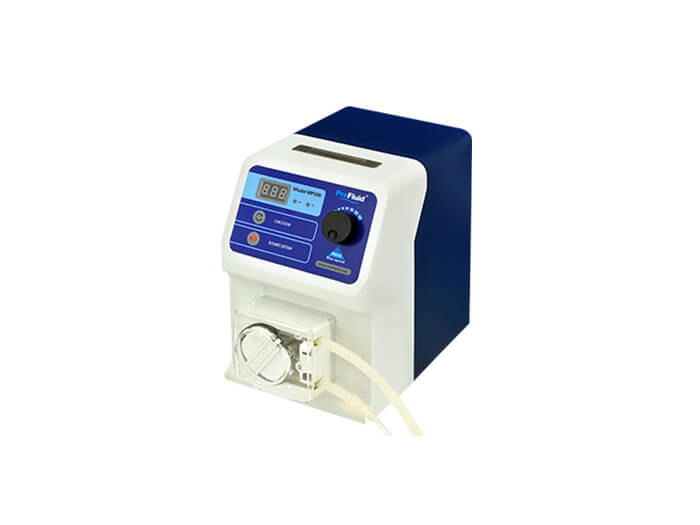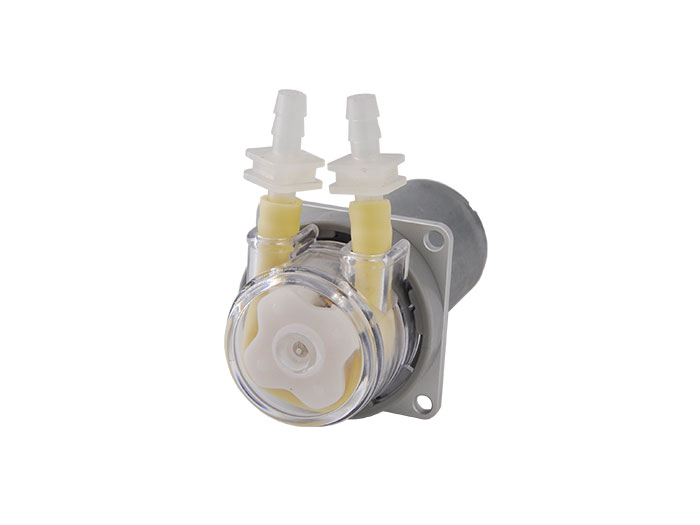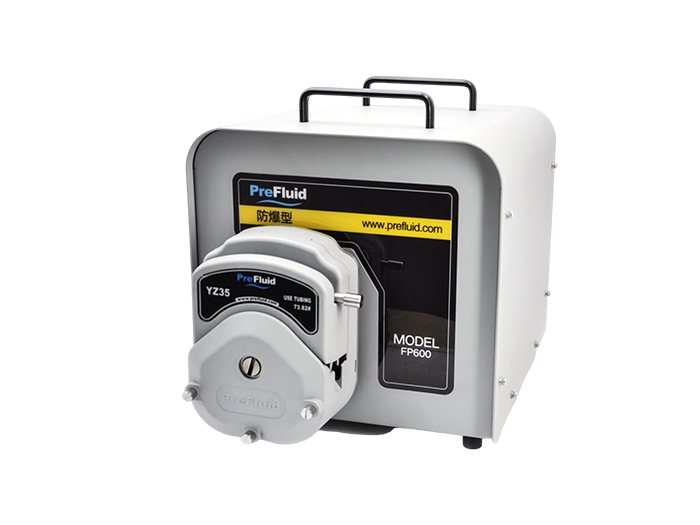1) Reciprocating positive displacement pump: the reciprocating displacement of the components in the working chamber (plunger, diaphragm, etc.) changes the working chamber volume, so that the transported liquid is discharged according to the specified flow rate of the fluid machinery.
1) Reciprocating positive displacement pump: the reciprocating displacement of the components in the working chamber (plunger, diaphragm, etc.) changes the working chamber volume, so that the transported liquid is discharged according to the specified flow rate of the fluid machinery.
2) Stroke volume: The displacement element (plunger, etc.) in the working chamber for reciprocating movement - times, under the control of the isolation element (valve group, seal), without considering any volume loss in the working chamber is sucked (or discharged fluid calculation volume. It is equal to the product of the section area of the plunger and the stroke length.
3) Calibration curve: under rated conditions, the relationship between flow calibration curve and measurement accuracy and relative stroke length during normal operation of the pump is a comprehensive curve drawn on the same curve, and the factory test of conventional products only takes stability accuracy as measurement accuracy.
4) Flow calibration curve: under rated conditions, using mathematical statistical regression operation method, the multiple flow measurements corresponding to each relative stroke length are returned into a curve (usually a straight line) between the flow and the relative stroke length measured in the actual operation of the pump for comparison, flow or relative stroke length adjustment.
5) Measurement accuracy E(%): under rated conditions, measured linearity (EL) stability accuracy (Es) and reproducibility accuracy (Era) general term, expressed in percentage. Conventional products only test the stability and reproducibility of the pump. According to the national standard (GB/T7782-2008 metering pump), the flow measurement accuracy of the metering pump under rated conditions and the maximum relative stroke length should not be less than +1%. API 675-1994 (R2000) "Positive Displacement pump-Metering pump" standard states that "the repeatability of the flow rate shall be within +3% of the rated flow rate of the specified regulation ratio." :
a) Linearity (EL): The ratio of the difference between a single flow value measured at any relative stroke length and the corresponding calibrated flow rate to the maximum flow rate under rated conditions. EL= 100%*(Qi-Qc)/Qmax.
b) Stability accuracy (ES): under rated conditions, the relative limit error between the measured flow value and the maximum flow rate measured continuously at the same - relative stroke position:
c) Reproducibility accuracy (Era): the relative limit error of a set of discontinuous flow measurements to the maximum flow rate under rated conditions.
6) Metering pump adjustment range and adjustment ratio: metering pump is a positive displacement pump whose stroke can be adjusted, and its stroke volume can be adjusted arbitrarily within the range of 0~ 100%, which is mainly for the mechanical adjustment part of the metering pump, that is, the adjustment range of stroke (eccentricity) is 0~ 100%.
Adjustment ratio: refers to the rated flow and the minimum flow rate that can be obtained when maintaining the specified stability accuracy and the specified linearity, expressed by the ratio. - The general regulation ratio is 10:1 (accuracy is +3%), and the regulation ratio for high pressure and small flow pumps (especially diaphragm pumps) is higher than 10:2.
7) Recommended adjustment ratio: under rated conditions, the flow rate (or relative stroke length) of the metering pump can be adjusted (%) under the premise that the linearity, stability accuracy and repeatability accuracy measured in the relative stroke length of each group are not lower than the rated measurement accuracy (conventional product factory test only assesses the stability accuracy).
8) Metering pump flow:
The flow of the metering pump is divided into theoretical flow, rated flow, maximum (measured) flow and stroke flow.
(1) Theoretical flow rate: without considering any volume loss of the pump, the flow rate calculated according to the main structural parameters of the pump (maximum stroke volume) and pump speed;
(2) Rated flow: under rated conditions (temperature, pressure, etc.), the design stipulates that the pump should discharge the nominal flow value from the pump outlet during normal operation;
(3) The maximum (measured) flow rate: under the rated conditions (temperature, pressure, etc.) and the maximum (100%) stroke, the pump measured discharge flow from the pump outlet during normal operation;
(4) stroke flow: under rated conditions (temperature, pressure, etc.), the discharge flow measured from the pump outlet in the specified stroke during normal operation;
According to the national standard (GB/T7782-2008 metering pump), "the actual flow value of the pump under rated conditions should not be lower than the rated flow value of the pump." (JB/ T53192-1999 metering pump quality grade) stipulates that "the actual flow under rated conditions" should be controlled within "(100~ 120) % rated flow value ". The standard AP1675-1994 (R2000) "Positive Displacement pump-Metering pump" states that "the rated capacity shall be at least 110% of the specified maximum capacity."
(5) the actual flow value of the pump: the actual flow value of the metering pump under rated conditions (maximum stroke, rated pressure, rated working conditions) is generally greater than the rated flow value of the pump, for the flow value can not be simply calculated according to the percentage of the rated flow multiplied by the length of the stroke, and the error between the calculated value and the measured value can not be assessed according to the metering accuracy of the pump. The measurement accuracy is only to assess the stability accuracy and reproducibility accuracy of the flow rate of the pump under the specified stroke, and has nothing to do with the size of the specific value.
9) The performance curve of the metering pump: The performance curve of the metering pump is to indicate the size of the corresponding flow under different strokes and pressures, and it mainly has two, namely, stroke and flow (Q-S) and pressure and flow (Q-P), where the change curve of stroke and flow is the main curve to guide users. The performance curve of the pump can only be based on the pump in the factory test, according to the test method specified in the "metering pump" standard, the flow value of each group measured under different strokes and pressures of the pump, and the flow calibration curve of the pump can be calculated. When the user's working condition is not different from the factory test, the flow calibration curve of the pump can be adjusted according to the factory flow calibration curve. According to the national factory test standards, the metering pump factory test is carried out in accordance with the normal temperature water conditions (except for the special media test specified by the user), if the user uses the medium and the physical properties of the factory test (temperature, specific gravity, viscosity, particle size, etc.) the difference is large, before the formal use, the user should use the transport medium, re-calibrate the flow curve under the working conditions. Users often ask our factory to improve the performance curve of the pump when bidding or ordering, these curves can only be theoretical (or empirical), can not replace the actual performance curve of the pump.
The theoretical performance curve of the metering pump should be an oblique straight line, but not 45° (100% stroke point and the maximum flow value of the line segment length set at the same time), should be > 46°; The starting point of the diagonal line is not at 0 point, but at 3% ~ 6% stroke point, and the position of small flow and high pressure stroke point is larger; The diagonal of < 10% is represented by a dashed line, because the flow accuracy error of < 10% stroke is large, generally not assessed; The maximum measured flow at rated pressure is generally 110% rated flow, the higher the rated pressure, the smaller the flow richness, and the measured flow at zero pressure is close to the theoretical flow.


